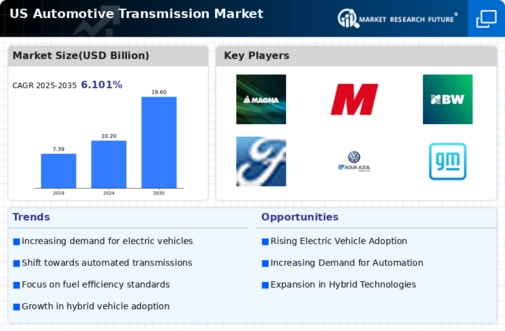Rising Demand for Fuel Efficiency
The automotive transmission market is experiencing a notable shift towards fuel-efficient vehicles, driven by consumer preferences and regulatory mandates. As fuel prices fluctuate, consumers increasingly seek vehicles that offer better mileage, prompting manufacturers to innovate in transmission technologies. The market for automatic transmissions, which are often more efficient than manual counterparts, is projected to grow significantly. In 2025, the demand for fuel-efficient vehicles is expected to account for approximately 40% of new car sales in the US. This trend compels manufacturers to invest in advanced transmission systems that enhance fuel economy, thereby influencing the automotive transmission market.
Growth of Electric and Hybrid Vehicles
The automotive transmission market is witnessing a transformation due to the increasing popularity of electric and hybrid vehicles. As consumers become more environmentally conscious, the demand for vehicles that utilize alternative powertrains is on the rise. In 2025, electric and hybrid vehicles are projected to constitute approximately 30% of new vehicle sales in the US. This shift necessitates the development of specialized transmission systems that cater to the unique requirements of electric drivetrains. Consequently, the automotive transmission market is adapting to accommodate these changes, leading to innovations in transmission design and functionality.
Government Regulations and Emission Standards
The automotive transmission market is heavily influenced by stringent government regulations aimed at reducing vehicle emissions. In the US, the Environmental Protection Agency (EPA) has set ambitious targets for fuel economy and greenhouse gas emissions, compelling manufacturers to adopt more efficient transmission technologies. By 2025, it is anticipated that vehicles must achieve an average fuel economy of 54.5 mpg, which necessitates advancements in transmission systems. Compliance with these regulations drives innovation and investment in the automotive transmission market, as manufacturers strive to meet or exceed these standards while maintaining vehicle performance.
Technological Advancements in Transmission Systems
The automotive transmission market is significantly impacted by rapid technological advancements. Innovations such as dual-clutch transmissions (DCT) and continuously variable transmissions (CVT) are gaining traction due to their ability to optimize performance and efficiency. In 2025, it is estimated that DCTs will represent around 25% of the market share, reflecting a growing preference for high-performance vehicles. Furthermore, the integration of smart technologies, including adaptive transmission control systems, enhances driving experience and vehicle responsiveness. These advancements not only improve fuel efficiency but also contribute to the overall competitiveness of the automotive transmission market.
Consumer Preferences for Advanced Driving Experiences
The automotive transmission market is significantly shaped by evolving consumer preferences for advanced driving experiences. As technology becomes more integrated into vehicles, consumers increasingly favor features such as seamless gear shifts and enhanced control. The demand for automatic and semi-automatic transmissions is on the rise, with projections indicating that these systems will account for over 70% of new vehicle sales by 2025. This trend reflects a broader desire for convenience and performance, prompting manufacturers to focus on developing sophisticated transmission solutions that enhance the overall driving experience in the automotive transmission market.

















Leave a Comment